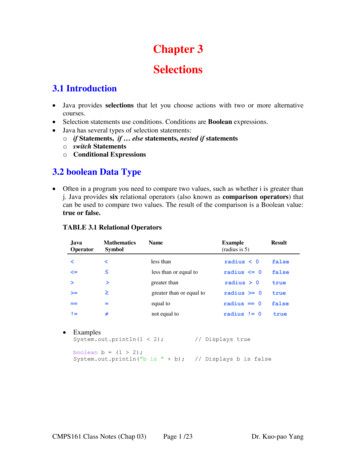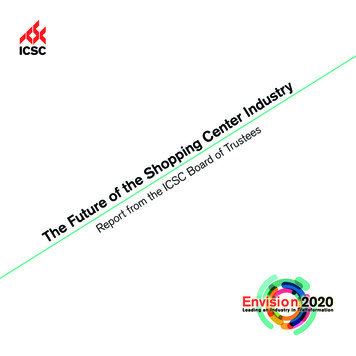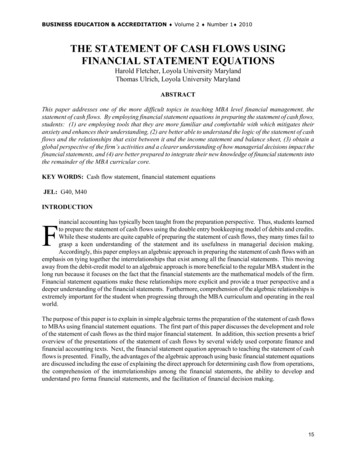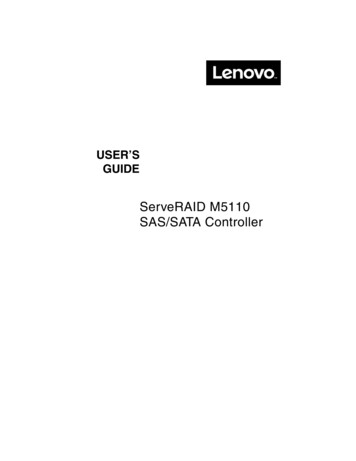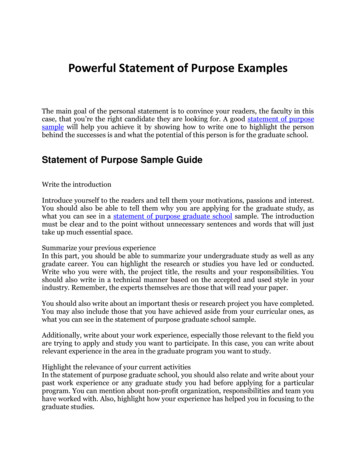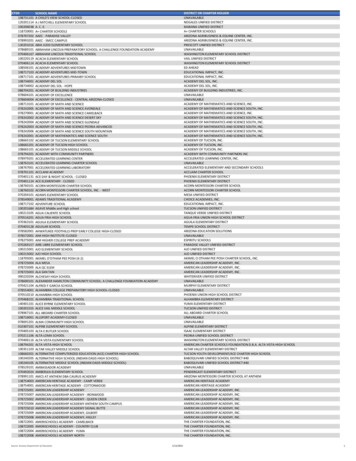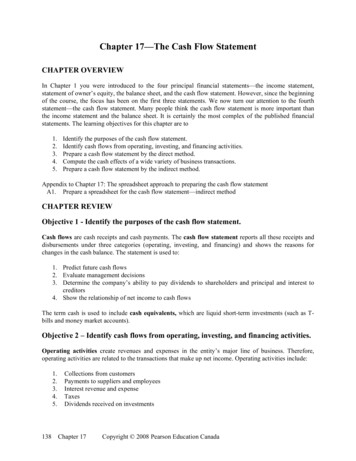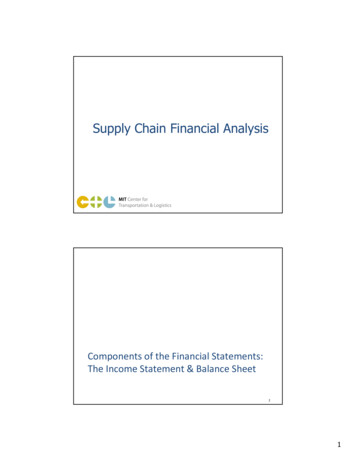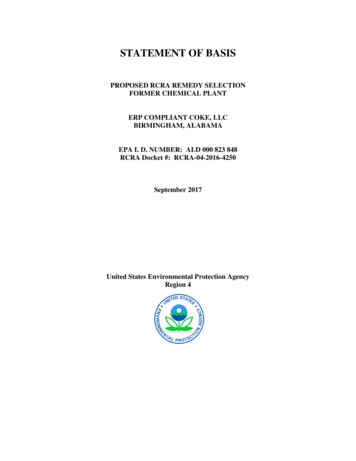
Transcription
STATEMENT OF BASISPROPOSED RCRA REMEDY SELECTIONFORMER CHEMICAL PLANTERP COMPLIANT COKE, LLCBIRMINGHAM, ALABAMAEPA I. D. NUMBER: ALD 000 823 848RCRA Docket #: RCRA-04-2016-4250September 2017United States Environmental Protection AgencyRegion 4
TABLE OF CONTENTS1. EXECUTIVE SUMMARY . 32. FACILITY BACKGROUND. 4Table 1. Identified SWMU Management Areas (SMAs) . 4Table 2. Identified SWMUs and AOC at SMA 4 – Former Chemical Plant . 43. SUMMARY OF ENVIRONMENTAL SETTING . 54. SUMMARY OF NATURE AND EXTENT OF CONTAMINATION . 55. SUMMARY OF INTERIM MEASURES . 66. SUMMARY OF FACILITY RISKS . 7Table 3. Evaluation of Remediation Triggers . 77. SCOPE OF CORRECTIVE MEASURES . 88. FACILITY-SPECIFIC CORRECTIVE MEASURE (REMEDY) OBJECTIVES . 9Table 4. Facility-Specific Corrective Measure Objectives . 99. SUMMARY OF REMEDIAL ALTERNATIVES AND REMEDY EVALUATION . 9Table 5. List of Considered Remedial Alternatives . 10Table 6. List of Retained Remedial Alternatives . 10Table 7. Comparative Analysis of Corrective Action Alternatives .1010. PROPOSED REMEDY . 1111. CLEANUP STANDARDS . 12Table 8. Numeric Cleanup Standards for Facility-Specific Groundwater Objective 4 (GroundwaterRestoration) and Groundwater Objective 5 (Hydraulic Control) . 12Table 9. Numeric Cleanup Standards for Facility-Specific Groundwater Objective 6 (SourceRemoval) and Soil Objective 3 (Leaching) . 13Table 10. Numeric Cleanup Standards for Facility-Specific Soil Objectives 1 and 2 (Land UseControls) . 13Table 11. Narrative (Non-Numeric) Cleanup Standards for Facility-Specific Soil Objectives 1 and 2and Groundwater Objective 7 (Land Use Controls) . 1412. PUBLIC COMMENT PERIOD – OCTOBER 1 TO NOVEMBER 14, 2017 . 15Table 12. Viewing Locations for the Administrative Record . 1513. PUBLIC MEETING/HEARING . 1614. POST PUBLIC COMMENT PERIOD. 16FIGURE 1.FIGURE 2:FIGURE 3:FIGURE 4.Facility Location, SWMU Management Areas . 17Subsurface Soil . 18Surface Soil . 19Groundwater Plume, Extraction Wells, Monitoring Wells . 202
Quick SB Fact: The SB provides generalbackground information and summarizes theremedial alternatives evaluation process andidentifies the remedy EPA is proposing toprotect human health and the environment.This SB has the following four-fold purposes: Identify the proposed remedy Describe the process of consideringremedial options Solicit public review Provide information on publicinvolvement in remedy selection1. EXECUTIVE SUMMARYThis Statement of Basis (SB) is for the FormerChemical Plant present at ERP Compliant Coke,LLC, a coke manufacturer located at 3500 35thAvenue North, Birmingham, Alabama.Specifically, this document sets forth the U.S.Environmental Protection Agency (EPA) Region 4’s proposed corrective measure(remedy) for the Former Chemical Plant,pursuant to a Resource Conservation andRecovery Act (RCRA; pronounced 'rick-ra')Section 3008(h) Administrative Order onConsent (Order; Docket Number: RCRA-042016-4250). The Former Chemical Plant is oneof the five study areas identified at the Facilityand addressed by the Order.Accordingly, these documents are available forreview during the 45-day public commentperiod, which runs from October 1, 2017, toNovember 14, 2017.During the 45-day public comment period, theEPA will be accepting comments on theproposed remedy, which consists of Land UseControls In-Situ Soil Source Area Treatment Groundwater Removal and Treatment Groundwater Monitoring, as discussed in thisSB. The Agency may modify its proposedremedy described herein or select anothercorrective measure alternative based on newinformation or on public comments.On September 17, 2012, the EPA issued aRCRA Order to Walter Coke. The 2012 Orderoutlined requirements for Walter Coke tofinalize corrective measure studies andimplementation at forty-five (45) Solid WasteManagement Units (SWMUs) and six (6) Areasof Concern (AOCs). The 2012 Order built uponand closed out a previous 1989 RCRA Section3008(h) Administrative Order, which triggerednumerous environmental studies on-site and offsite over the past 23 years on this 400-acreFacility.Please see Sections 12 and 13 of the SB for thelocations of the Administrative Record, how tosubmit written comments to the EPA, and theupcoming public meeting/hearing.The Walter Coke facility was purchased by ERPCompliant Coke in February 2016 out ofbankruptcy proceedings. As part of thebankruptcy settlement, the new owner assumedthe environmental responsibilities identified inthe 2012 Order with Walter Coke. OnAugust 11, 2016, the 2012 Order was modifiedand re-issued to note the ownership change.Upon conclusion of the public comment period,the EPA will issue a final determination and, ifcomments are received, a Response toComments.RCRA’s Relation to EPA SuperfundActions: Basically, RCRA is addressing onsite (and directly related offsite) contaminationat the ERP Compliant Coke facility. The EPASuperfund Program, through its designation ofthe 35th Avenue Superfund Site, is addressingcontamination within the community.Because this SB merely summarizesinformation that can be found in greater detail indocuments contained in the AdministrativeRecord (e.g., investigation and evaluationreports), EPA encourages the interested publicto review these documents in order to gain amore comprehensive understanding.3
2. FACILITY BACKGROUNDThe roots of the 400-acre ERP Compliant Coke facility can be traced back to 1881 when SlossSheffield Steel and Iron Company first began producing pig iron in Birmingham, Alabama. In 1920,Sloss-Sheffield Steel and Iron Company built two coke oven batteries to serve its own needs as well asthose of other customers. As Birmingham's steel industry grew, so did the need for furnace coke, whichprompted the construction of three more batteries at the Facility during the 1950s. Beginning in 1952,the company experienced a series of corporate transactions and restructurings that culminated in thename change to Walter Coke in May 2009. The Walter Coke facility was purchased by ERP CompliantCoke in February 2016 out of bankruptcy proceedings.The Former Chemical Plant manufacturing began in 1948, and all chemical manufacturing operationsceased in 2002 (Figure 1). The primary product lines coming out of the Former Chemical Plant werefoundry catalyst used in sand cast foundry molds to make iron pipe and other foundry products. Inaddition, a mineral wool plant, which manufactured mineral fiber used in the production of ceiling tileand insulating products, was built in late 1947 and was decommissioned in 2010. Other product lines atthe facility, now discontinued, included iron from the blast furnace plant which operated from 1951 to1979. Currently, the facility produces foundry coke and furnace coke in the Coke Manufacturing Plant,located generally to the west of the Former Chemical Plant.As part of the bankruptcy settlement, ERP Compliant Coke assumed the environmental responsibilitiesidentified in a 2012 Order with Walter Coke. On August 11, 2016, the 2012 Order was modified and reissued to note the ownership change. Like the 2012 Order, the 2016 Order requires finalization ofcorrective measure studies and implementation at forty-five (45) Solid Waste Management Units(SWMUs) and six (6) Areas of Concern (AOCs). The 2016 Order is designed to be a “roadmap” foraccomplishing site-wide clean-up at all on-site SWMUs and AOCs, which have been grouped into five(5) SWMU Management Areas (SMAs) (Table 1, Figure 1).Table 1. Identified SWMU Management Areas (SMAs)SMA 1 - Biological Treatment FacilitySMA 2 - Land Disposal AreaSMA 3 - Coke Manufacturing PlantSMA 4 - Former Chemical PlantSMA 5 - Former Pig Iron FoundryEach SMA is being studied separately to identify cleanup options and to identify protective cleanupstandards. After reviewing the results from past investigations and studies, EPA believes that correctivemeasures are necessary at SMA 4 – the Former Chemical Plant, which has fourteen identified units ofinterest (Table 2). The other 4 SMAs will be addressed via separate Statements of Basis (SB).Table 2. Identified SWMUs and AOC at SMA 4 – Former Chemical PlantSMWU 26 – Main Process BuildingSWMU 33 – Plant Drum Storage AreaSWMU 27 – Floor Drain SystemSWMU 34 – Wastewater Neutralization SystemSWMU 28 – Sulfonation Floor DrainSWMU 35 – Mineral Wool Waste PilesSWMU 29 – Product Tank Containment AreaSWMU 36 – Used Oil TankSWMU 42 – Former Above Ground Storage TanksSWMU 30 – Centrifuge Waste Water Tank(ASTs)AOC B – Drainage Ditch next to Shuttlesworth DriveSWMU 31 – Monohydrate Floor Drain and Sumpand 35th AvenueAOC D – Former Chemical Plant (FCP) GroundwaterSWMU 32 – Drum Storage AreaPlume
One of the units listed in Table 2 for the Former Chemical Plant, the Mineral Wool Piles (SWMU 35),deserves further explanation based on past community interest. The Mineral Wool Piles reach heights of 75 feet and have been estimated by the Facility to contain 2 million cubic yards of material. Theorigin of the Mineral Wool Piles rests with the Facility’spast Fiber Division, which operated five coke-fired cupolafurnaces that melted basic steel blast furnace slag and otherminerals for the purpose of manufacturing slag-basedmineral fiber. This fiberous material is variously calledmineral, rock or slag wool insulation (see inset picture). Itis made from rock and blast furnace slag which are meltedGeneric Mineral Wooland spun into fibers to resemble the texture of wool.Mineral wool comes in batts, rolls or loose-fill forms. Likefiberglass, it is also used throughout a house in sidewalls, attics, floors, crawl spaces, cathedral ceilings,and basements. The majority of the product produced by the Facility was packaged in 700 lb. bales tobe utilized for ceiling tile wool.The Mineral Wool Piles consist of Slag Wool Aggregate, which was a co-product of the former slagwool fiberization process. The Mineral Wool Piles contains fibrous material and non-fibrous materialthat was removed from the fiber as part of the product cleaning process. The chemistry of Slag WoolAggregate is identical to that of the fiber product; but it contains much less of the fiberized form of thematerial.3. SUMMARY OF ENVIRONMENTAL SETTINGThe Facility is underlain by sedimentary rocks (e.g., limestone). At SMA 4, industrial fill material ispresent at thicknesses ranging from 0.5 to 6 feet. The native soil over the bedrock consists of clays. Ingeneral, there are three zones of groundwater movement beneath the Facility, including SMA 4:1) fill/soil (shallow flow zone - 20 ft or less below ground surface),2) the soil-bedrock interface or shallow bedrock (intermediate flow zone - 20 to 50 ft belowground surface), and3) the deep bedrock (bedrock flow zone – deeper than 50 ft below ground surface).Due to the complex nature of area soils and bedrock, the rate and direction of groundwater flow variesfrom one zone to another, as well as within each zone. The intermediate flow zone is much more porousand permeable than the other two zones, and it is the main contaminated groundwater zone at SMA 4.SMA 4 does not contain any aquatic or terrestrial habitats of interest (e.g., ponds, forests).4. SUMMARY OF NATURE AND EXTENT OF CONTAMINATION(What is Contaminated and Where is the Contamination?)A brief summary of the nature and extent of contamination is presented below for SMA 4. Subsurface Soil: Subsurface soil samples were collected from a total of 74 locations. Based onthe operating history of the Facility, the following categories of constituents underwentlaboratory analysis: volatile organic chemicals (VOCs, e.g., benzene), semi-volatile organicchemicals (SVOCs, e.g., benzo(a)pyrene), and metals (e.g., arsenic). Constituents within each of5
these chemical categories were not found in any distinct or concentrated area(s); rather, theconstituents were dispersed throughout the subsurface of SMA 4 (Figure 2). Specifically, of the74 subsurface samples collected/analyzed:o four soil samples detected constituents at levels above the preliminary cleanup (i.e.,benzo(a)pyrene at 29 ppm and 98 ppm vs. a preliminary cleanup goal of 28 ppm; benzeneat 760 ppm vs. a preliminary cleanup goal of 409 ppm; toluene at 56,000 ppm vs. apreliminary cleanup goal of 21,785 ppm).o thirty-one soil samples detected at least one constituent above their respective screeninglevels used to evaluate concentrations that present a potential threat for futurecontamination of groundwater.Surface Soil (0-1 foot): Except for the Drainage Ditch (AOC B), surface soil samples were notcollected in SMA 4 because the areas not containing structures were covered by concrete, asphaltsurfaces or naturally hard surfaces (mineral wool). Ten soil samples were collected in theDrainage Ditch and analyzed for volatile organic chemicals (VOCs, e.g., benzene), semi-volatileorganic chemicals (SVOCs, e.g., benzo(a)pyrene), and metals (e.g., arsenic). The main detectedconstituents were arsenic and a few semi-volatiles (e.g., benzo(a)pyrene) (Figure 3). Three ditchsamples detected arsenic at 23 ppm, 25 ppm and 26 ppm, which is above the preliminary cleanupgoal for arsenic of 19 ppm. Two ditch samples detected benzo(a)pyrene at 3.4 ppm and 7.7 ppm,which is above the preliminary cleanup goal of 2.8 ppm.Groundwater: A total of 18 monitoring wells have been installed to address SMA 4. The mainconstituents seen in the groundwater are volatile organic compounds (e.g., benzene) and semivolatile organic compounds (e.g., benzo(a)pyrene), and the preliminary cleanup standards formultiple constituents are exceeded and make up a contaminated groundwater plume that isapproximately 550 ft x 800 ft in size within the shallow bedrock (Figure 4).Mineral Wool Piles: To assess the piles, 8 samples were collected and 16 analyses made forvolatile organic chemicals (VOCs, e.g., benzene), semi-volatile organic chemicals (SVOCs, e.g.,benzo(a)pyrene), and metals (e.g., arsenic, cyanide). A few metals (e.g., arsenic, chromium) anda few SVOCs (e.g., benzo(a)pyrene) were found to be slightly above their respective industrialscreening levels.5. SUMMARY OF INTERIM MEASURES(What Cleanup has Already Occurred?)The groundwater plume at SMA 4 is composed primarily of volatiles, both dissolved phasehydrocarbons (e.g., benzene) and chlorinated solvents (e.g., chlorobenzene) that have migrated to thedowngradient property boundary along Shuttlesworth Drive. To begin addressing this plume, which hadbegun to migrate offsite, EPA approved an Interim Measures plan in 2012 whose performance objectiveis to establish pumping rates in the containment wells to maintain an inward gradient along a segment ofthe property line and thereby control migration. A secondary benefit of hydraulic containment ischemical mass removal. Groundwater removal is currently accomplished through 6 extraction wells.Eighteen monitoring wells are currently used to assess the effectiveness of the extraction system (Figure4). The containment wells, and the associated well monitoring, have been successfully operating sincethe Spring of 2013.To assess concern over the potential for vapors from the Former Chemical Plant’s groundwater tomigrate and enter nearby homes, quarterly sampling (i.e., May 2013, August 2013, November 2013, andFebruary 2014) of the air in and around a home across Shuttlesworth Drive occurred. The study’sobjective was to determine the potential for and nature and extent of any adverse vapor intrusion by6
collecting and analyzing air from three areas: subsurface house crawlspace and outside air. EPAconcurred with the study’s evaluation in 2015 that the potential for vapor intrusion from nearbycontaminated groundwater has been adequately investigated, and vapor intrusion from the groundwaterplume appears to have little to no potential to increase contaminant concentrations in indoor air. Inaddition, operation of the groundwater removal system helps to further reduce the source of potentialvapors that might enter nearby structures in the future.6. SUMMARY OF FACILITY RISKS(What Risks Exist?)Part of the decision process in determining whether remediation of detected contaminants is neededincludes determining if the detected contaminant concentrations pose unacceptable risks to human healthor the environment. This risk is evaluated for each potential exposure pathway based on considerationof current and reasonably expected future uses of the Facility and maximum beneficial use of groundwater. Once the beneficial uses are determined, cleanup levels to protect those uses are established,which then helps with determining the scope of the remediation.Investigations at SMA 4 indicate that soil contains semi-volatile organics (e.g., benzo(a)pyrene) andmetals (e.g., arsenic), and groundwater contains volatile organics (e.g., benzene) and semi-volatileorganics (see Section 5). These detected contaminants were used in the development of a Baseline RiskAssessment where the potential adverse health effects are analyzed for various routes of exposure (e.g.,ingestion, inhalation, dermal) associated with the contaminated soil and groundwater. Because theFacility’s current use and reasonably expected future use are as an operating industrial facility withrestricted access, industrial/commercial workers and constructions workers were the two main groups(i.e., receptors) whose risk was assessed. To account for possible facility access without permission, thepotential risk to an adolescent trespasser was also assessed.Consideration of possible remedial action (i.e., cleanup actions) is required if the Facility’scontamination fails any one of the four standard EPA remediation triggers. As shown in Table 3, someof the remediation triggers have been exceeded at SMA 4.Table 3. Evaluation of Remediation TriggersEPA The cumulative excesscarcinogenic site risk toan individual exceeds0.0001 (i.e., ne Risk Assessment FindingCumulative excess carcinogenic site risk was calculated tobe 2.7E-03 and 1.6E-02, current and future riskrespectively. Groundwater is the predominant factor inexceeding the cumulative site risk.Cumulative excess carcinogenic site risk was calculated tobe 5.6E-04 and 5.6E-04, current and future riskrespectively. Groundwater is the predominant factor inexceeding the cumulative site risk.Cumulative excess carcinogenic site risk was calculated tobe 5.6E-06 for both current and future risk.For adult and child residents, the excess carcinogenic riskfrom the Mineral Wool Piles via an inhalation route ofexposure was found to be 1.9E-07 and 2.3E-07,respectively.***7Is there anIdentified Risk toAssess for PossibleCleanup?YesYesNoNo
Table 3. Evaluation of Remediation TriggersEPA tionWorkerThe non-carcinogenichazard index is greaterthan 1 (i.e., 1E 00).**TrespasserResidentNon-carcinogenic hazard index was calculated to be2.9E 02 and 6.2E 02, current and future risk respectively.Groundwater is the predominant factor in exceeding thecumulative site risk.Non-carcinogenic hazard index was calculated to be3.7E 02 and 3.7E 02, current and future respectively.Groundwater is the predominant factor in exceeding thecumulative site risk. Subsurface soil is also a minorcontributing factor in exceeding the cumulative site risk.Non-carcinogenic hazard index was calculated to be 1.4E02 for both current and future risk.For adults and children, the noncancer hazard index for theMineral Wool Piles via an inhalation route of exposurewas calculated to be 8.6E-05 and 1.7E-04,respectively.***Is there anIdentified Risk toAssess for PossibleCleanup?YesYesNoNoSite contaminants causeadverse environmentalimpacts.No areas of ecological significance exist at SMA 4.NoChemical-specificstandards are exceeded.Drinking water standards (aka maximum contaminant levels (MCL)) havebeen exceeded in wells within SMA 4 for the following constituents:Benzene, Chlorobenzene, Cis-1,2-Diclhoroethene, and Vinyl Chloride.YesNotes*A risk level of 1E-04 represents an increase of one additional person out of 10,000 developing cancer over the courseof a lifetime of exposure. Risks calculated to exceed 1E-04 for a receptor are deemed to have exceeded a protectivelevel and remedial action is needed. When a facility’s calculated cumulative risk for a receptor exceeds 1E-04, EPA’sgoal is to reduce the threat from carcinogenic contaminants such that, for any medium, the excess lifetime risk ofcancer to such a receptor generally falls within a range from one in ten thousand to one in one million (i.e., 1E-04 to1E-06).**As the hazard index exceeds 1.0, the potential for adverse health effects increases. Risks calculated to exceed 1.0 aredeemed to have exceeded a protective level and remedial action is needed.*** Given the community’s concern regarding the Mineral Wool Piles, the risk to nearby residents from the piles wasevaluated as if it were soil. Although the risk assessment was based on the facility’s current and reasonably expectedfuture uses as an operating industrial facility with restricted access, in the case of the Mineral Wool Piles, it is possiblethat some material from the pile may become airborne, disperse in wind, and migrate off-site causing some exposure.Because of this potentially complete pathway, nearby residents (both adult and children) were evaluated for inhalationexposure to the constituents present in the Mineral Wool Piles.7. SCOPE OF CORRECTIVE MEASURES(Where is Cleanup Needed?)Based on the cumulative site risk established by the Baseline Risk Assessment (Section 6), preliminarycleanup standards were established. Comparison of these preliminary cleanup standards to the detectedconcentrations can identify areas where remediation may be necessary. The following are the riskmanagement conclusions on which environmental media require action to protect human health. SoilGroundwater8
8. FACILITY-SPECIFIC CORRECTIVE MEASURE (REMEDY) OBJECTIVES(What Site-Specific Objectives are needed for a Protective Cleanup?)Facility-specific Corrective Measure Objectives form the basis for evaluating potential remedialtechnologies to address the Facility’s contamination in a manner that is protective of the identified risksto be addressed. These objectives were crafted with consideration of the three general CorrectiveMeasure Performance Standards used in any remedy evaluation (see Section 9) and were based on anevaluation of the Facility investigation results and the Baseline Risk Assessment, including anypreliminary cleanup standards developed in conjunction with the current and reasonably expected landand groundwater uses and their identified routes of exposure to humans and ecological receptors.No environmental receptors were identified in the investigation of SMA 4; therefore, the Facilityspecific Corrective Measure Objectives listed in Table 4 are solely to protect human health fromcontamination at SMA 4.Table 4. Facility-Specific Corrective Measure tive Measures ObjectiveMaintain, in perpetuity, land use as industrial, a setting that has been found to be protective forthe detected soil concentrations.Ensure that industrial/commercial workers, construction workers, and trespassers are notexposed to unacceptable levels of soil contaminants.Minimize the potential for soil contaminants to leach and contaminant groundwater or adverselyimpact groundwater cleanup.Restore groundwater to maximum beneficial use, which in this case is as a drinking wateraquifer.*While aquifer restoration is sought, hydraulically control the groundwater plume in order tokeep contamination that is above identified cleanup standards from expanding and/or migratingoffsite.Remove significant sources of subsurface mass.**While aquifer restoration is sought, control current land use exposures (e.g.,industrial/commercial workers, construction workers, and trespassers) and potential futureexposures (residents) to groundwater above the identified cleanup standards.Notes*It is EPA’s policy to determine protective media cleanup objectives for groundwater remedies considering the use,value, and vulnerability of the groundwater resource, and all potential pathways that could result in human orecological exposure to contaminants (Final Comprehensive State Ground Water Protection Program Guidance,December 1992). Typically, the groundwater use designation or classification system is the starting point fordetermining the appropriate reasonable expected uses and exposures to evaluate risks and identify groundwatercleanup levels.**Reaching restoration of groundwater will not occur unless the original source is remediated/eliminated. In thiscontext, “sources” includes both the location of the original release as well as locations where significant mass ofcontaminants may have migrated and remain in a distinct geographic area.9. SUMMARY OF REMEDIAL ALTERNATIVES AND REMEDY EVALUATION(What Cleanup Approaches were Considered, and How were they Evaluated?)Remedial alternatives are combinations of cleanup technologies designed to meet the Facility-specificCorrective Measure Objectives (Section 8). The technologies retained from the technology screeningprocess were assembled into 5 preliminary alternatives that were believed to have a change at treating or9
containing the contaminants in soil and groundwater, protect human health, control the residualcontamination source, and reduce contaminant mass (Table 5).Table 5. List of Considered Remedial AlternativesAlternativeNo.12345DescriptionNo ActionPhysical, Legal, and Administrative Barriers (Land Use Controls)Land Use Controls Groundwater Long Term MonitoringLand Use Controls In-Situ Soil Source Area Treatment In-Situ Groundwater Treatment GroundwaterMonitoringLand Use Controls In-Situ Soil Source Area Treatment Groundwater Removal and Treatment Groundwater MonitoringThese 5 preliminary alternatives were then evaluated (screened) to arrive at a final set of remedialalternatives that would be evaluated in detail. Because all remedies must achieve and maintain longterm protection of human health and the environment, this evaluation/screening was made against thefollowing three EPA generated and standard Corrective Measure Performance Objectives (aka remedythreshold criteria). Protect human health and the environment,Attain media cleanup standards, andControl sources of releases to reduce or eliminate further releases that might pose threats tohuman health or the environment.For comparison purposes, the baseline alternative (Alternative 1) is always no action. The remaining 4alternatives at SMA 4 included the incremental addition of technologies to build a full range ofalternatives that might be able to address the contamination. Based on the screening process, 2 of the 5alternatives were found to satisfy the three Corrective Measure Performance Objectives and wereretained for further evaluation. The retained alternatives are listed in the Table 6.Table 6. List of Retained Remedial AlternativesAlternativeNo.45DescriptionLand Use Controls In-Situ Soil Source Area Treatment In-Situ Groundwater Treatment GroundwaterMonitoringLand Use Controls In-Situ Soil Source Area Treatment Groundwater Removal and Treatment Groundwater MonitoringThe detailed evaluation of Alternatives 4 and 5 used the following balancing criteria: Long-term Reliability and Effectiveness;Reduction of Toxicity, Mobility, or Volume;Short-term Effectiveness;Implementability; andCost.The detailed evaluation was conducted in two stages. Each alte
at the ERP Compliant Coke facility. The EPA Superfund Program, through its designation of the 35th Avenue Superfund Site, is addressing contamination within the community. 1. EXECUTIVE SUMMARY . This Statement of Basis (SB) is for the Former Chemical Plant present at ERP Compliant Coke,
